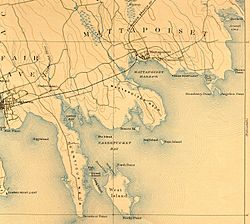Nasketucket River facts for kids
Quick facts for kids Nasketucket River |
|
|---|---|

Nasketucket River and vicinity, 1893.
|
|
| Other name(s) | Naskatucket River Nasketuckett River |
| Country | United States |
| State | Massachusetts |
| Region | Fairhaven |
| Physical characteristics | |
| Main source | 41°39′15″N 70°53′12″W / 41.65417°N 70.88667°W |
| River mouth | Little Bay 0 ft (0 m) 41°37′55″N 70°51′58″W / 41.63194°N 70.86611°W |
| Length | 3 mi (4.8 km) |
The Nasketucket River is a small but important river, or stream, located in Fairhaven, Massachusetts. It begins its journey in Fairhaven and flows for about 3 miles (about 4.8 kilometers). This short river eventually empties into Little Bay. Little Bay is a part of Nasketucket Bay, which then connects to the larger Buzzards Bay.
Contents
Discover the Nasketucket River
The Nasketucket River might be small, but it plays a big role in its local area. It's a freshwater stream that eventually mixes with the saltwater of Buzzards Bay. This mix creates a special environment called an estuary. Estuaries are super important for many different kinds of plants and animals.
Where is the Nasketucket River?
The Nasketucket River is found in the town of Fairhaven, Massachusetts. This town is located on the coast of southeastern Massachusetts. The river starts inland and flows towards the ocean. Its path takes it through different landscapes before reaching the bay.
- Source: The river begins in Fairhaven. The exact spot is around 41°39′15″N 70°53′12″W. This is where the river's journey starts.
- Length: It flows for about 3 miles (4.8 km). This makes it a relatively short river.
- Mouth: The river ends when it flows into Little Bay. Little Bay is a part of Nasketucket Bay, which is connected to Buzzards Bay. The mouth of the river is located at 41°37′55″N 70°51′58″W.
What Lives in the Nasketucket River?
Even small rivers like the Nasketucket can be home to a surprising variety of wildlife. The mix of fresh and saltwater near its mouth creates a unique habitat. This habitat supports many different species.
Fish and Aquatic Life
The river provides a home for various fish. Some fish might live there all year round. Others might use the river as a place to spawn (lay eggs) or as a nursery for their young.
- Small fish: Minnows and other small fish are common. They feed on tiny insects and plants in the water.
- Migratory fish: Some fish, like alewives or blueback herring, might swim up the river from the ocean. They do this to lay their eggs in freshwater.
- Shellfish: In the bay areas near the river's mouth, you might find clams, oysters, and mussels. These shellfish filter the water, helping to keep it clean.
Birds and Other Animals
The Nasketucket River and its surrounding areas attract many types of birds and other animals. They come to the river for food, water, and shelter.
- Waterfowl: Ducks, geese, and swans are often seen on the river. They feed on aquatic plants and small creatures.
- Wading birds: Herons and egrets might be spotted along the banks. They stand in the shallow water, waiting to catch fish or frogs.
- Mammals: You might see muskrats or otters swimming in the river. Raccoons and deer also visit the riverbanks. They come to drink water or search for food.
- Insects: Many insects, like dragonflies and damselflies, live near the river. They are an important food source for birds and fish.
Protecting the Nasketucket River
Rivers like the Nasketucket are important natural resources. They provide habitats for wildlife and can be used for recreation. Protecting these rivers is very important for the environment and for people.
Environmental Importance
The Nasketucket River helps keep the local ecosystem healthy.
- Water quality: The river helps to filter water as it flows towards the bay. Healthy rivers mean cleaner water for everyone.
- Habitat: It provides a home for many plants and animals. Protecting the river means protecting these species.
- Natural beauty: Rivers add to the beauty of the landscape. They offer peaceful places for people to enjoy nature.
Conservation Efforts
Local groups and environmental organizations often work to protect rivers. They try to keep the water clean and the habitats healthy.
- Monitoring: Scientists and volunteers regularly check the river's water quality. They look for pollution and other problems.
- Restoration: Sometimes, efforts are made to restore parts of the river. This might involve planting native plants along the banks. It can also mean removing obstacles that block fish migration.
- Education: Teaching people about the river's importance is key. When people understand, they are more likely to help protect it.
The Nasketucket River, though small, is a vital part of the Fairhaven environment. It connects the land to the sea and supports a rich variety of life.

